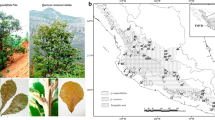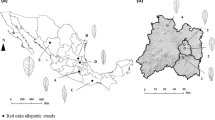Abstract
In forests worldwide, Quercus is a major genus; however, the boundaries between the constituent species are relatively weak, and hybridization is reported frequently. In this study, we examined Quercus acuta and Quercus sessilifolia (subgenus Cyclobalanopsis), which have a putative hybrid—Q. x takaoyamensis. We investigated leaf morphological traits and microsatellites of Q. acuta and Q. sessilifolia in the area where the two species are both found. Although the leaf traits overlapped, the two species could be distinguished morphologically as demonstrated by principal component analysis based on a range of these traits. They were also genetically differentiated, with F ST = 0.104. However, they shared most of the alleles at all eight loci examined, and considerable genetic admixing was detected. Admixture analysis demonstrated that Q. acuta and Q. sessilifolia, respectively, contained 11 and 24 % of individuals with a probability of less than 0.9 of being correctly assigned to their species. Model-based testing showed that this admixing was created by not only shared ancestral polymorphism but also by hybridization. Effective population size and migration rate were estimated using the coalescent approach. We estimated 8.843 and 71.98 effective numbers of migrants per generation to Q. acuta and Q. sessilifolia, respectively. Theoretically, one to ten migrants per generation are required to prevent complete genetic differentiation. Based on the results of this study, it appears that genetic admixing, with sharing of most alleles, is probably common in the two species and is maintained by interspecific introgressive hybridization.








Similar content being viewed by others
References
Abadie P, Roussel G, Dencausse B, Bonnet C, Bertocchi E, Louvet J-M, Kremer A, Garnier-Gere P (2012) Strength, diversity and plasticity of postmating reproductive barriers between two hybridizing oak species (Quercus robur L. and Quercus petraea (Matt) Liebl.). J Evol Biol 25:157–173
Arnold ML (1997) Natural hybridization and evolution. Oxford University Press, New York
Beaumont MA, Nichols RA (1996) Evaluating loci for use in the genetic analysis of population structure. Proc R Soc B 263:1619–1626
Beerli P (2006) Comparison of Bayesian and maximum-likelihood inference of population genetic parameters. Bioinformatics 22:341–345
Beerli P, Felsenstein J (2001) Maximum likelihood estimation of a migration matrix and effective population sizes in n subpopulations by using a coalescent approach. Proc Natl Acad Sci 98:4563–4568
Beerli P, Palczewski M (2010) Unified framework to evaluate panmixia and migration direction among multiple sampling locations. Genetics 185:313–326
Bull LN, Pabon-Pena CR, Freimer NB (1999) Compound microsatellite repeats: practical and theoretical features. Genome Res 9:830–838
Butlin RK (2010) Population genomics and speciation. Genetica 138:409–418
Campana MG, Hunt HV, Jones H, White J (2011) Corrsieve: software for summarizing and evaluating Structure output. Mol Ecol Resour 11:349–352
Cavender-Bares J, Pahlich A (2009) Molecular, morphological, and ecological niche differentiation of sympatric sister oak species, Quercus virginiana and Q. geminata (Fagaceae). Am J Bot 96:1690–1702
Ciofi C, Beaumont MA, Swingland IR, Bruford MW (1999) Genetic divergence and units for conservation in the Komodo dragon Varanus komodoensis. Proc R Soc B 266:2269–2274
Evanno G, Regnaut S, Goudet J (2005) Detecting the number of cluster of clusters of individuals using the software STRUCTURE: a simulation study. Mol Ecol 14:2611–2620
Falush D, Stephens M, Pritchard JK (2003) Inference of population structure using multilocus genotype data: linked loci and correlated allele frequencies. Genetics 164:1567–1587
Field DL, Ayre DJ, Whelan RJ, Young AG (2011) Patterns of hybridization and asymmetrical gene flow in hybrid zones of the rare Eucalyptus aggregata and common E. rubida. Heredity 106:841–853
Goudet J (2001) FSTAT, a program to estimate and test genetic diversities and fixation indices (version 2.9.3). Available from <http://www2.unil.ch/popgen/softwares/fstat.htm>.
Guichoux E, Garnier-Gere P, Lagache L, Lang T, Boury C (2013) Outlier loci highlight the direction of introgression in oaks. Mol Ecol 22:450–462
Hedrick PW (2005) A standardized genetic differentiation measure. Evolution 59:1633–1638
Huang C, Zhang Y, Bartholomew B (1999) Fagaceae. In: Wu Z-Y, Raven PH (eds) Flora of China, vol 4. Science Press, Beijing, pp 314–400
Isagi Y, Suhandono S (1997) PCR primers amplifying microsatellite loci of Quercus myrsinifolia Blume and their conservation between oak species. Mol Ecol 6:897–899
Ito S, Ohtsuka K, Yamashita T (2007) Ecological distribution of seven evergreen Quercus species in southern and eastern Kyushu, Japan. Veg Sci 24:53–63
Jakobusson M, Rosenberg NA (2007) CLUMPP: a cluster matching and permutation program for dealing with label switching multimodality in analysis of population structure. Bioinformatics 23:1801–1806
Johnsson H (1945) Interspecific hybridization within the genus Betula. Hereditas 31:163–176
Jost L (2008) G ST and its relatives do not measure differentiation. Mol Ecol 17:4015–4026
Kampfer S, Lexer C, Glossl J, Steinkellner H (1998) Characterization of (GA)n microsatellite loci from Quercus robur. Hereditas 129:183–186
Kobayashi Y, Midorikawa T (1959) Dendrological studies of the Japanese Fagaceae: On the ripening term of the fruits of Quercus, Castanopsis and Pasania. Bull Gov For Exp Station 117:11–42 (in Japanese)
Lepais O, Petit RJ, Guichoux E, Lavabre JE, Alberto F, Kremer A, Gerber S (2009) Species relative abundance and direction of introgression in oaks. Mol Ecol 18:2228–2242
Lepais O, Roussel G, Hubert F, Kremer A, Gerber S (2013) Strength and variability of postmating reproductive isolating barriers between four European white oak species. Tree Genet Genomes 9:841–853
Lewis D, Crowe LK (1958) Unilateral interspecific incompatibility in flowering plants. Heredity 12:233–256
Lexer C, Kremer A, Petit RJ (2006) Shared alleles in sympatric oaks: recurrent gene flow is a more parsimonious explanation than ancestral polymorphism. Mol Ecol 15:2007–2012
Link WA, Barker RJ (2010) Bayesian inference with ecological applications. Academic Press, London
Makino T (1920) A contributions to the knowledge of the flora of Japan. J Jpn Bot 2:13–16
Martinsen GD, Whitham TG, Turek RJ, Keim P (2001) Hybrid populations selectively filter gene introgression between species. Evolution 55:1325–1335
Matsumoto A, Kawahara T, Kanazashi A, Yoshimaru H, Takahashi M, Tsumura Y (2009) Differentiation of three closely related Japanese oak species and detection of interspecific hybrids using AFLP markers. Botany 87:145–153
Mills LS, Allendorf FW (1996) The one-migrant-per-generation rule in conservation and management. Conserv Biol 10:1509–1518
Moran EV, Willis J, Clark JS (2012) Genetic evidence for hybridization in red oaks (Quercus sect. Lobatae, Fagaceae). Am J Bot 99:92–100
Muir G, Schlotterer C (2005) Evidence for shared ancestral polymorphism rather than recurrent gene flow at microsatellite loci differentiating two hybridizing oaks (Quercus spp.). Mol Ecol 14:549–561
Ohashi H, Ohashi K, Takahashi K (2006) Identify of Quercus acuta Thunb. (Fagaceae) recorded from Taiwan and China. Jpn J Bot 81:268–274 (in Japanese)
Ohba H (2006) Fagaceae. In: Iwatsuki K, Boufford DE, Ohba H (eds) Flora of Japan, vol IIa. Kodansha Scientific, Tokyo, pp 42–60
Ohyama M, Baba K, Itoh T (1999) Possibility of grouping of Cyclobalanopsis species (Fagaceae) grown in Japan based on an analysis of several regions of chloroplast DNA. J Wood Sci 45:498–501
Ohyama M, Baba K, Itoh T (2001) Wood identification of Japanese Cyclobalanopsis species (Fagaceae) based on DNA polymorphism of the intergenic spacer between trnT and trnL 5' exon. J Wood Sci 47:81–86
Palme AE, Su Q, Palsson S, Lascoux M (2004) Extensive sharing of chloroplast haplotypes among European birches indicates hybridization among Betula pendula, B. pubescens and B. nana. Mol Ecol 13:167–178
Petit RJ, Bodenes C, Ducousso A, Roussel G, Kremer A (2003) Hybridization as a mechanism of invasion in oaks. New Phytol 161:151–164
Plummer M, Best N, Cowles K, Vines K (2006) CODA: convergence diagnosis and output analysis for MCMC. R News 6:7–11
Potts BM, Dungey HS (2004) Interspecific hybridization of Eucalyptus: key issues for breeders and geneticists. New For 27:115–138
Pritchard JK, Stephens M, Donnelly P (2000) Inference of population structure using multilocus genotype data. Genetics 155:945–959
R Development Core Team (2012) R: A language and environment for statistical computing. R Foundation for Statistical Computing, Vienna
Scotti-Saintagne C, Mariette S, Porth I, Goicoechea PG, Barreneche T, Bodenes C, Burg K, Kremer A (2004) Genome scanning for interspecific differentiation between two closely related oak species [Quercus robur L. and Q. petraea (Matt.) Liebl.]. Genetics 168:1615–1626
Steinhoff S (1993) Results of species hybridizaition with Quercus robur L and Quercus petraea (Matt) Liebl. Ann For Sci 50:137s–143s
Steinkellner H, Fluch S, Turetschek E, Lexer C, Streiff A, Kremer A, Burg K, Glossl J (1997) Identification and characterization of (GA/CT) n -microsatellite loci from Quercus petraea. Plant Mol Biol 33:1093–1096
Stettler RF, Zsuffa L, Wu R (1996) The role of hybridization in the genetic manipulation of Populus. In: Stettler RF, Bradshaw HD, Heilman PE, Hinckley TM (eds) Biology of Populus: and its implications for management and conservation, vol I. NRC Research Press, Ontario, pp 87–112
Tiffin P, Olson MS, Moyle LC (2001) Asymmetrical crossing barriers in angiosperms. Proc R Soc B 268:861–867
Ueno S, Taguchi Y, Tsumura Y (2008) Microsatellite markers derived from Quercus mongolica var. crispula (Fagaceae) inner bark expressed sequence tags. Genes Genet Syst 83:179–187
Ueno S, Tsumura Y (2008) Development of ten microsatellite markers for Quercus mongolica var. crispula by database mining. Conserv Genet 9:1083–1085
Valbuena-Carabana M, Gonzalez-Martinez SC, Sork VL, Soto A, Goicoechea PG (2005) Gene flow and hybridization in a mixed oak forest (Quercus pyrenaica Willd. and Quercus petraea (Matts.) Liebl.) in central Spain. Heredity 95:457–465
Van Oosterhout C, Hutchinson WF, Wills DPM, Shipley P (2004) MICRO-CHECKER: Software for identifying and correcting genotyping errors in microsatellite data. Mol Ecol Notes 4:535–538
Via S (2009) Natural selection in action during speciation. Proc Natl Acad Sci 106:9939–9946
Wang J (2004) Application of the one-migrant-per-generation rule to conservation and management. Conserv Biol 18:332–343
Weir BS, Cockerham CC (1984) Estimating F-statistics for the analysis of population structure. Evolution 38:1358–1370
Wilson GA, Rannala B (2003) Bayesian inference of recent migration rates using multilocus genotypes. Genetics 163:1177–1191
Wright S (1931) Evolution in Mendelian populations. Genetics 16:97–159
Yamashita T, Nagai Y, Shoji T (1999) Quercus takaoyamensis Makino and Q. sessilifolia Blume (Fagaceae) at Jourakuji in Fuchu-machi, Toyama Prefecture. Bull Bot Gard Toyama 4:43–46 (in Japanese with English abstract)
Yan L, Zhe-Kun Z (2002) Leaf architecture in Quercus subgenus Cyclobalanopsis (Fagaceae) from China. Bot J Linn Soc 140:283–295
Zeng Y-F, Liao W-J, Petit RJ, Zhang D-Y (2011) Geographic variation in the structure of oak hybrid zones provides insights into the dynamics of speciation. Mol Ecol 20:4995–5011
Acknowledgments
We are grateful to N. Tomaru, S. Setsuko, N. Nakanishi, and Y. Hasegawa for their support with the genetic experiment; M. Tsuruta, T. Okada, Y. Watanabe, and H. Tabata for useful discussions; and N. Yanagisawa, K. Tsuda, and the members of the Laboratory of Satoyama for their help with the sample collections. We also thank the two anonymous reviewers for their helpful comments on the previous manuscript.
Conflict of interest
The authors declare that they have no conflict of interest.
Data archiving statement
We follow standard Tree Genetics and Genomes policy, and all geotype and phenotype data are deposited in the Dryad Repository doi:10.5061/dryad.c959s.
Author information
Authors and Affiliations
Corresponding author
Additional information
Communicated by I. J. Chybicki
Electronic supplementary material
Below is the link to the electronic supplementary material.
ESM 1
(PDF 166 kb)
Rights and permissions
About this article
Cite this article
Tamaki, I., Okada, M. Genetic admixing of two evergreen oaks, Quercus acuta and Q. sessilifolia (subgenus Cyclobalanopsis), is the result of interspecific introgressive hybridization. Tree Genetics & Genomes 10, 989–999 (2014). https://doi.org/10.1007/s11295-014-0737-x
Received:
Revised:
Accepted:
Published:
Issue Date:
DOI: https://doi.org/10.1007/s11295-014-0737-x




